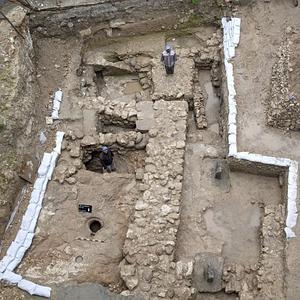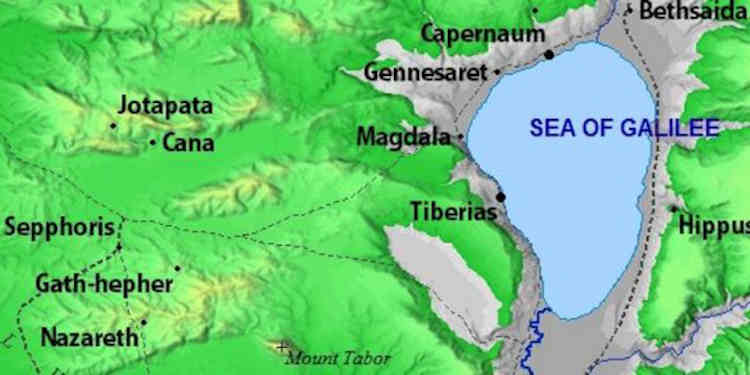In the last few decades there have been significant archaeological discoveries relating to first century Palestine, including Jesus’ home town of Nazareth.
No-one expects to find the words of the Sermon on the Mount inscribed in stone, or a bust of Jesus to be found underneath Jerusalem. But many discoveries have thrown light on the world Jesus inhabited – its geography, customs and religious beliefs.
Discoveries at Nazareth
Present day Nazareth is a densely-packed city of almost 80,000 inhabitants, so the opportunities for archaeological digs are limited. Nevertheless in recent decades, archaeologists have excavated:

- tombs and graves,
- a farm including a winepress, watchtowers, stone irrigation channels and agricultural terraces,
- the remains of two houses.
Coins, pottery and other artefacts found at the sites indicate these structures were in existence in the first century. They would presumably have been familiar to Jesus.
Life in Nazareth
Dr Ken Dark of Reading University in the UK has been one of the principle archaeologists in these excavations. Dark has recently published a book, Roman-Period and Byzantine Nazareth and its Hinterland, which provides a “social and economic interpretation” of Nazareth over several centuries, including the period of Jesus.
While I haven’t read the book (I decided not to spend $A242 purchasing it!), several reports based on the book provide interesting information.
Larger than once thought
Previously archaeologists thought that Nazareth was a small village of maybe 400 inhabitants. But Ken Dark thinks the evidence points to a larger village or town, maybe up to 1000 people. Its inhabitants engaged in agricultural activities, growing grapes, olives, and grain on terraces cut into the limestone hills.
Conservative and Jewish
Galilee was a mixed Jewish and non-Jewish region. Most of the rural community was Jewish, but the cities of Tiberius and Sepphoris, built by the king Herod Antipas, had a significant Greco-Roman influence.
Herod and his family, installed as political leaders by the occupying Romans, were generally despised by the Jews because they collaborated with the Romans and didn’t follow strict Jewish religious laws.
Sepphoris was only about 6 km from Nazareth, and was probably visible from there. The archaeology shows that some of the Galileans living in or close to Sepphoris adopted some Roman cultural behaviours and were looser in their application of Jewish purity laws. This is in marked contrast to the inhabitants of Nazareth:
- Nazareth farmers respected the strict Jewish preference to not use human excrement as fertiliser, while in Sepphoris they had no such qualms. The Essene sect prohibited the use of human excrement, and it may be that Nazareth had an Essene influence.
- The inhabitants of Nazareth were strict in their choice of bowls and cups. They commonly used stone, which was considered to be immune from ritual and spiritual impurity. The ceramics they used were produced in a village 37 km to the north, and therefore known to be from strictly religious Jewish sources that kept them ritually pure during manufacture. On the other hand, artefacts from Sepphoris show a much wider variety and less concern for ritual purity.
- Archaeologists have found a network of caves dug into the Nazareth rock, that seem likely to have been used as protection against the Roman armies during the Jewish revolt of 67-70 CE. This suggests that some inhabitants of Nazareth may have joined the rebellion. Sepphoris, however, remained loyal to the Romans during the revolt.
Relevance to the life of Jesus
Ken Dark speculates that Nazareth was a conservative and anti-Roman town. If so, residents would likely have been critical of Jesus’ more relaxed or critical attitude to the strict Jewish purity laws (see Mark 7:1-23). This fits with the negative response to Jesus in Nazareth as recorded in Luke 4:14-30 and Mark 6:1-6.
The Nazareth myth?
There have been authors, none of them scholars, who have contested the findings of the archaeologists. These claims were generally made before some of the recent discoveries, and proponents have struggled to defend their scepticism against the growing body of information.
Ken Dark’s summary of the archaeological finds is surely the death knell to these claims.
Other recent archaeology
Some other finds elsewhere are relevant to the life of Jesus:
- the remains of synagogues in a small village 17 km east of Nazareth and in Magdala, and possibly in Capernaum – scholars had doubted the gospel stories of Jesus preaching in Galilean synagogues, but these discoveries have confirmed those accounts;
- a first century fishing boat capable of seating 12 people, found in the Sea of Galilee;
- a house in Capernaum dating from the first century, and believed by some to be the home of the apostle Peter;
- the discovery in Jerusalem of the Pool of Bethesda with its five porticos, as described in John 5.
Read more
Biblical story of Jesus possibly explained by excavations in his hometown of Nazareth. Owen Jarus, Live Science, April 2020.
New archaeological evidence from Nazareth reveals religious and political environment in era of Jesus. David Keys, Independent, April 2020.
Map: Bibleatlas.org. Photo: Archaeological excavation of remains of first century house in Nazareth (Israel Antiquities Authority).

James Micheners “The Source” though a novel was an excellent source of conjectural information about that area and time.
I have heard of the book but I didn’t realise that was what it was about.